engine oil YAMAHA GIGGLE50 2009 Owners Manual
[x] Cancel search | Manufacturer: YAMAHA, Model Year: 2009, Model line: GIGGLE50, Model: YAMAHA GIGGLE50 2009Pages: 74, PDF Size: 0.9 MB
Page 6 of 74
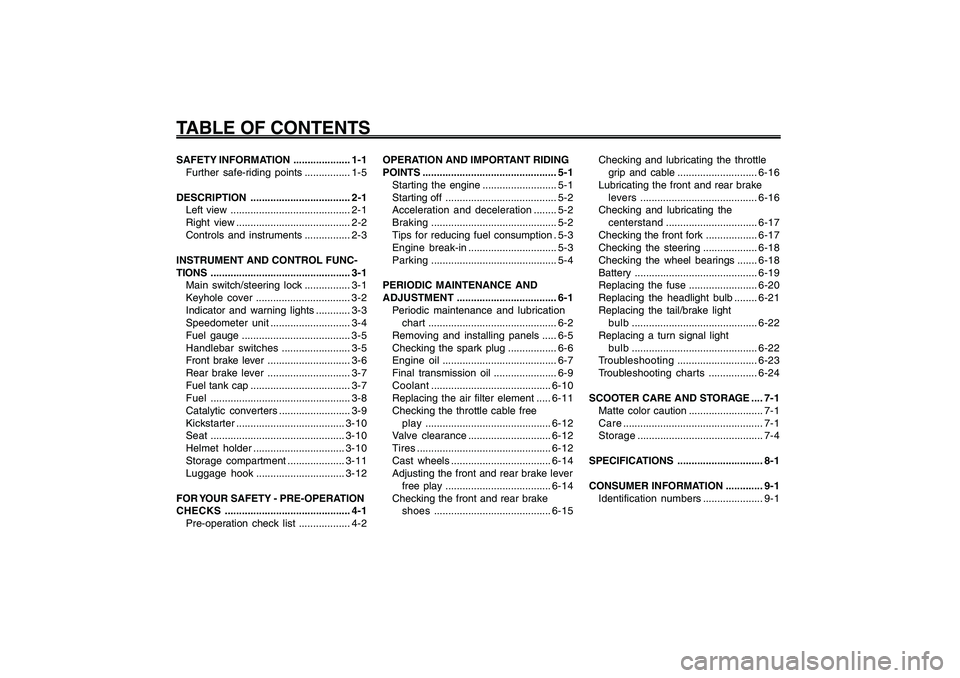
1
2
3
4
5
6
7
8
9
EAU10210
TABLE OF CONTENTSSAFETY INFORMATION .................... 1-1
Further safe-riding points ................ 1-5
DESCRIPTION ................................... 2-1
Left view .......................................... 2-1
Right view ........................................ 2-2
Controls and instruments ................ 2-3
INSTRUMENT AND CONTROL FUNC-
TIONS................................................. 3-1
Main switch/steering lock ................ 3-1
Keyhole cover ................................. 3-2
Indicator and warning lights ............ 3-3
Speedometer unit............................ 3-4
Fuel gauge ...................................... 3-5
Handlebar switches........................ 3-5
Front brake lever ............................. 3-6
Rear brake lever ............................. 3-7
Fuel tank cap ................................... 3-7
Fuel................................................. 3-8
Catalytic converters ......................... 3-9
Kickstarter......................................3-10
Seat...............................................3-10
Helmet holder................................3-10
Storage compartment ....................3-11
Luggage hook...............................3-12
FOR YOUR SAFETY - PRE-OPERATION
CHECKS............................................ 4-1
Pre-operation check list .................. 4-2OPERATION AND IMPORTANT RIDING
POINTS............................................... 5-1
Starting the engine .......................... 5-1
Starting off ....................................... 5-2
Acceleration and deceleration........ 5-2
Braking............................................ 5-2
Tips for reducing fuel consumption . 5-3
Engine break-in............................... 5-3
Parking............................................ 5-4
PERIODIC MAINTENANCE AND
ADJUSTMENT................................... 6-1
Periodic maintenance and lubrication
chart............................................. 6-2
Removing and installing panels ..... 6-5
Checking the spark plug ................. 6-6
Engine oil........................................ 6-7
Final transmission oil ...................... 6-9
Coolant..........................................6-10
Replacing the air filter element .....6-11
Checking the throttle cable free
play............................................6-12
Valve clearance.............................6-12
Tires...............................................6-12
Cast wheels ...................................6-14
Adjusting the front and rear brake lever
free play .....................................6-14
Checking the front and rear brake
shoes.........................................6-15Checking and lubricating the throttle
grip and cable ............................6-16
Lubricating the front and rear brake
levers.........................................6-16
Checking and lubricating the
centerstand................................6-17
Checking the front fork ..................6-17
Checking the steering ...................6-18
Checking the wheel bearings .......6-18
Battery ...........................................6-19
Replacing the fuse ........................6-20
Replacing the headlight bulb ........6-21
Replacing the tail/brake light
bulb............................................6-22
Replacing a turn signal light
bulb............................................6-22
Troubleshooting............................6-23
Troubleshooting charts.................6-24
SCOOTER CARE AND STORAGE .... 7-1
Matte color caution .......................... 7-1
Care................................................. 7-1
Storage............................................ 7-4
SPECIFICATIONS.............................. 8-1
CONSUMER INFORMATION ............. 9-1
Identification numbers..................... 9-1
Page 30 of 74
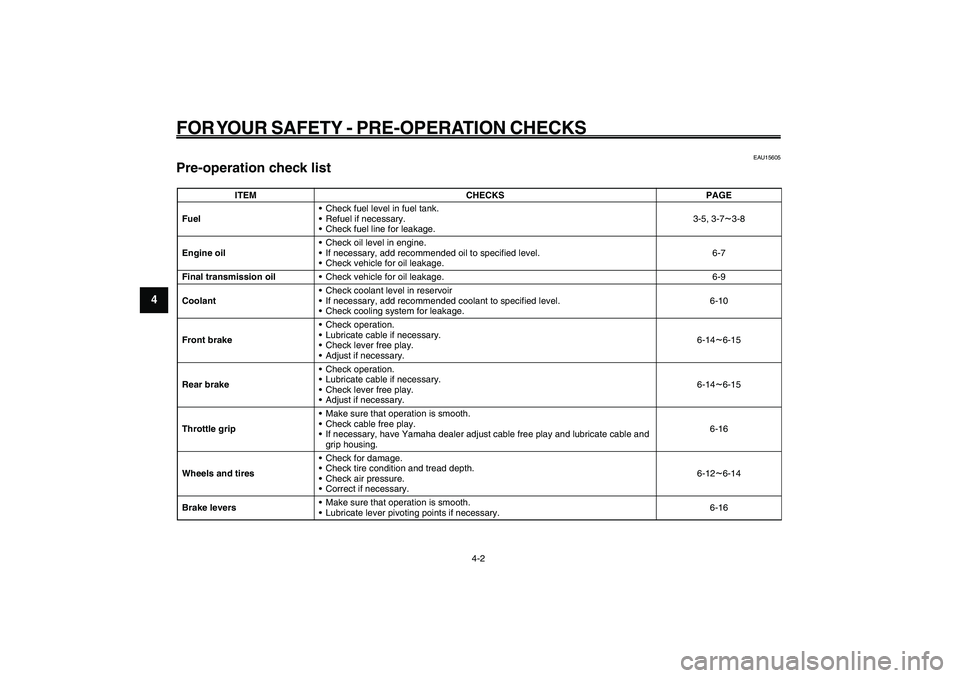
4-30
1
2
3
4
5
6
7
8
9
EAU15582
FOR YOUR SAFETY - PRE-OPERATION CHECKS
4-2
EAU15605
Pre-operation check listPre-operation check list
ITEM CHECKS PAGE
Fuel• Check fuel level in fuel tank.
• Refuel if necessary.
• Check fuel line for leakage.3-5, 3-7
~3-8
Engine oil• Check oil level in engine.
• If necessary, add recommended oil to specified level.
• Check vehicle for oil leakage.6-7
Final transmission oil• Check vehicle for oil leakage. 6-9
Coolant• Check coolant level in reservoir
• If necessary, add recommended coolant to specified level.
• Check cooling system for leakage.6-10
Front brake• Check operation.
• Lubricate cable if necessary.
• Check lever free play.
• Adjust if necessary.6-14
~6-15
Rear brake• Check operation.
• Lubricate cable if necessary.
• Check lever free play.
• Adjust if necessary.6-14~6-15
Throttle grip• Make sure that operation is smooth.
• Check cable free play.
• If necessary, have Yamaha dealer adjust cable free play and lubricate cable and
grip housing.6-16
Wheels and tires• Check for damage.
• Check tire condition and tread depth.
• Check air pressure.
• Correct if necessary.6-12~6-14
Brake levers• Make sure that operation is smooth.
• Lubricate lever pivoting points if necessary.6-16
Page 34 of 74
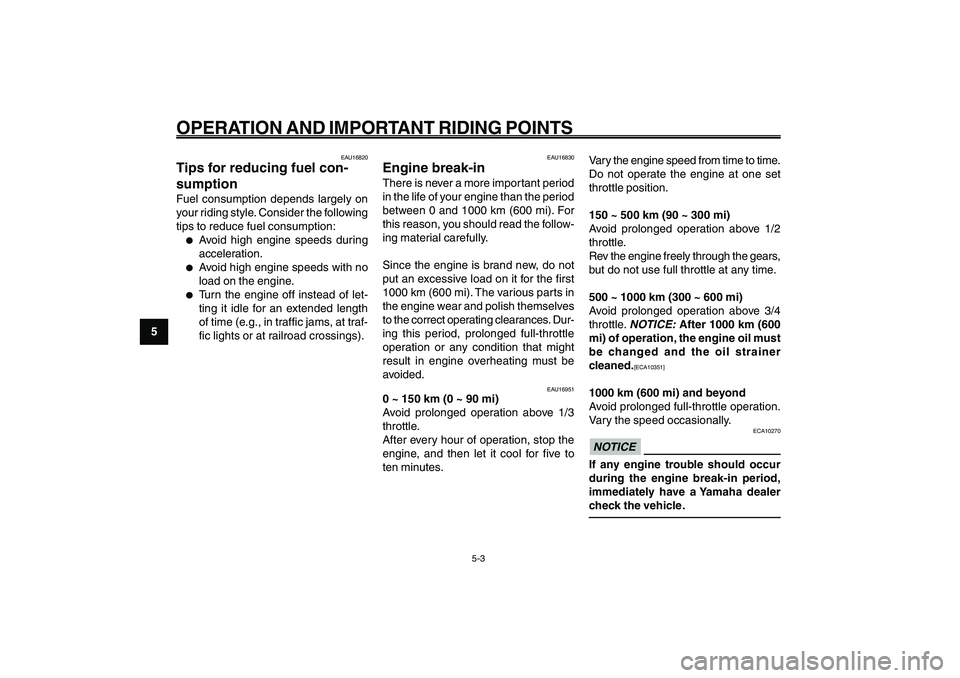
5-34
1
2
3
4
5
6
7
8
9
EAU15943
OPERATION AND IMPORTANT RIDING POINTS
5-3
EAU16830
Engine break-inThere is never a more important period
in the life of your engine than the period
between 0 and 1000 km (600 mi). For
this reason, you should read the follow-
ing material carefully.
Since the engine is brand new, do not
put an excessive load on it for the first
1000 km (600 mi). The various parts in
the engine wear and polish themselves
to the correct operating clearances. Dur-
ing this period, prolonged full-throttle
operation or any condition that might
result in engine overheating must be
avoided. Fuel consumption, tips for reducing
Engine break-in
EAU16820
Tips for reducing fuel con-
sumptionFuel consumption depends largely on
your riding style. Consider the following
tips to reduce fuel consumption:●
Avoid high engine speeds during
acceleration.
●
Avoid high engine speeds with no
load on the engine.
●
Turn the engine off instead of let-
ting it idle for an extended length
of time (e.g., in traffic jams, at traf-
fic lights or at railroad crossings).
EAU16951
0 ~ 150 km (0 ~ 90 mi)
Avoid prolonged operation above 1/3
throttle.
After every hour of operation, stop the
engine, and then let it cool for five to
ten minutes.Vary the engine speed from time to time.
Do not operate the engine at one set
throttle position.
150 ~ 500 km (90 ~ 300 mi)
Avoid prolonged operation above 1/2
throttle.
Rev the engine freely through the gears,
but do not use full throttle at any time.
500 ~ 1000 km (300 ~ 600 mi)
Avoid prolonged operation above 3/4
throttle.
NOTICE:
After 1000 km (600
mi) of operation, the engine oil must
be changed and the oil strainer
cleaned.
[ECA10351]
1000 km (600 mi) and beyond
Avoid prolonged full-throttle operation.
Vary the speed occasionally.
ECA10270
NOTICEIf any engine trouble should occur
during the engine break-in period,
immediately have a Yamaha dealer
check the vehicle.
Page 38 of 74
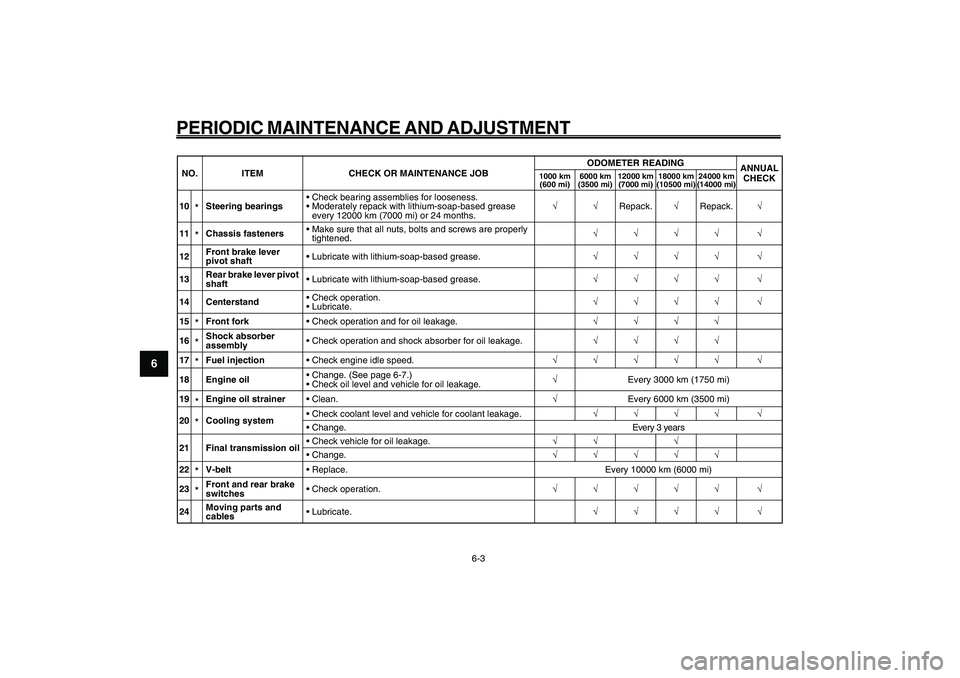
6-38
1
2
3
4
5
6
7
8
9
EAU1722A
PERIODIC MAINTENANCE AND ADJUSTMENT
6-3
10
*Steering bearings• Check bearing assemblies for looseness.
• Moderately repack with lithium-soap-based grease
every 12000 km (7000 mi) or 24 months.�—�—Repack.�—Repack.�—
11*Chassis fasteners• Make sure that all nuts, bolts and screws are properly
tightened.�—�—�—�— �—
12Front brake lever
pivot shaft• Lubricate with lithium-soap-based grease.�—�—�—�— �—
13Rear brake lever pivot
shaft• Lubricate with lithium-soap-based grease.�—�—�—�— �—
14 Centerstand• Check operation.
• Lubricate.�—�—�—�— �—
15*Front fork• Check operation and for oil leakage.�—�—�—�—
16*Shock absorber
assembly• Check operation and shock absorber for oil leakage.�—�—�—�—
17*Fuel injection• Check engine idle speed.�—�—�—�—�— �—
18 Engine oil• Change. (See page 6-7.)
• Check oil level and vehicle for oil leakage.�—Every 3000 km (1750 mi)
19
*Engine oil strainer•Clean.�—Every 6000 km (3500 mi)
20*Cooling system• Check coolant level and vehicle for coolant leakage.�—�—�—�— �—
• Change. Every 3 years
21 Final transmission oil• Check vehicle for oil leakage.�—�— �—
• Change.�—�—�—�—�—
22*V-belt• Replace. Every 10000 km (6000 mi)
23*Front and rear brake
switches• Check operation.�—�—�—�—�— �—
24Moving parts and
cables• Lubricate.�—�—�—�— �— NO. ITEM CHECK OR MAINTENANCE JOBODOMETER READING
ANNUAL
CHECK
1000 km
(600 mi)6000 km
(3500 mi)12000 km
(7000 mi)18000 km
(10500 mi)24000 km
(14000 mi)
Page 42 of 74

6-42
1
2
3
4
5
6
7
8
9
EAU1722A
PERIODIC MAINTENANCE AND ADJUSTMENT
6-7
To install the spark plug
1. Measure the spark plug gap with a
wire thickness gauge and, if nec-
essary, adjust the gap to specifi-
cation.Spark plug gap:
0.7 ~ 0.8 mm (0.028 ~ 0.031 in)2. Clean the surface of the spark plug
gasket and its mating surface, and
then wipe off any grime from the
spark plug threads.
3. Install the spark plug with the spark
plug wrench, and then tighten it to
the specified torque.Tightening torque:
Spark plug:
TIP
If a torque wrench is not available when
installing a spark plug, a good estimate
of the correct torque is 1/4~1/2 turn past
finger tight. However, the spark plugshould be tightened to the specified
torque as soon as possible.
4. Install the spark plug cap.
5. Install the panel.
EAUT2592
Engine oilThe engine oil level should be checked
before each ride. In addition, the oil must
be changed and the oil strainer cleaned
at the intervals specified in the periodic
maintenance and lubrication chart.
To check the engine oil level
1. Place the vehicle on the
centerstand. A slight tilt to the side
can result in a false reading.
2. Start the engine, warm it up for sev-
eral minutes, and then turn it off.ZAUM00**
1
2
3
1. Engine oil filler cap
2. Maximum level mark
3. Minimum level mark
Engine oil
Page 43 of 74

6-43
1
2
3
4
5
6
7
8
9
EAU1722A
PERIODIC MAINTENANCE AND ADJUSTMENT
6-8
3. Wait a few minutes until the oil
settles, remove the oil filler cap,
wipe the dipstick clean, insert it
back into the oil filler hole (without
screwing it in), and then remove it
again to check the oil level.TIP
The engine oil should be between the
minimum and maximum level marks.4. If the engine oil is below the mini-
mum level mark, add sufficient oil
of the recommended type to raise
it to the correct level.
5. Insert the dipstick into the oil filler
hole, and then tighten the oil filler
cap.
To change the engine oil
1. Start the engine, warm it up for sev-
eral minutes, and then turn it off.
2. Place an oil pan under the engine
to collect the used oil.3. Remove the engine oil filler cap and
the engine oil drain bolt to drain the
oil from the crankcase.
ZAUM00**
1
1. Engine oil drain bolt4. Install the engine oil drain bolt, and
then tighten it to the specified
torque.Tightening torque:
Engine oil drain bolt:
ZAUM00**
1
1. Oil filler hole5. Refill with the specified amount of
the recommended engine oil, and
then install and tighten the oil filler
cap.Recommended engine oil:
See page 8-1.
Oil change quantity:
0.78 L (0.82 US qt, 0.69 Imp.qt)
ECA11670
NOTICE● ●● ●
●
Do not use oils with a diesel
specification of “CD” or oils of a
higher quality than specified. In
Page 44 of 74

6-44
1
2
3
4
5
6
7
8
9
EAU1722A
PERIODIC MAINTENANCE AND ADJUSTMENT
6-9
addition, do not use oils labeled
“ENERGY CONSERVING II” or
higher.
● ●● ●
●
Be sure no foreign material en-
ters the crankcase.
6. Start the engine, and then let it idle
for several minutes while checking
it for oil leakage. If oil is leaking,
immediately turn the engine off and
check for the cause.
7. Turn the engine off, and then check
the oil level and correct it if neces-
sary. Final transmission oil
EAUT1561
Final transmission oilThe final transmission case must be
checked for oil leakage before each ride.
If any leakage is found, have a Yamaha
dealer check and repair the scooter. In
addition, the final transmission oil must
be changed as follows at the intervals
specified in the periodic maintenance
and lubrication chart.
1. Start the engine, warm it up by
riding the scooter for several min-
utes, and then stop the engine.
2. Place the scooter on the
centerstand.
3. Place an oil pan under the final
transmission case to collect the
used oil.
ZAUM00**
1
2
1. Final transmission oil filler bolt
2. Final transmission oil drain bolt4. Remove the oil filler bolt and drain
bolt to drain the oil from the final
transmission case.
5. Install the final transmission oil
drain bolt, and then tighten it to the
specified torque.Tightening torque:
Final transmission oil drain bolt:
6. Refill with the specified amount of
the recommended final transmis-
sion oil, and then install the oil filler
bolt and tighten it to the specified
Page 45 of 74
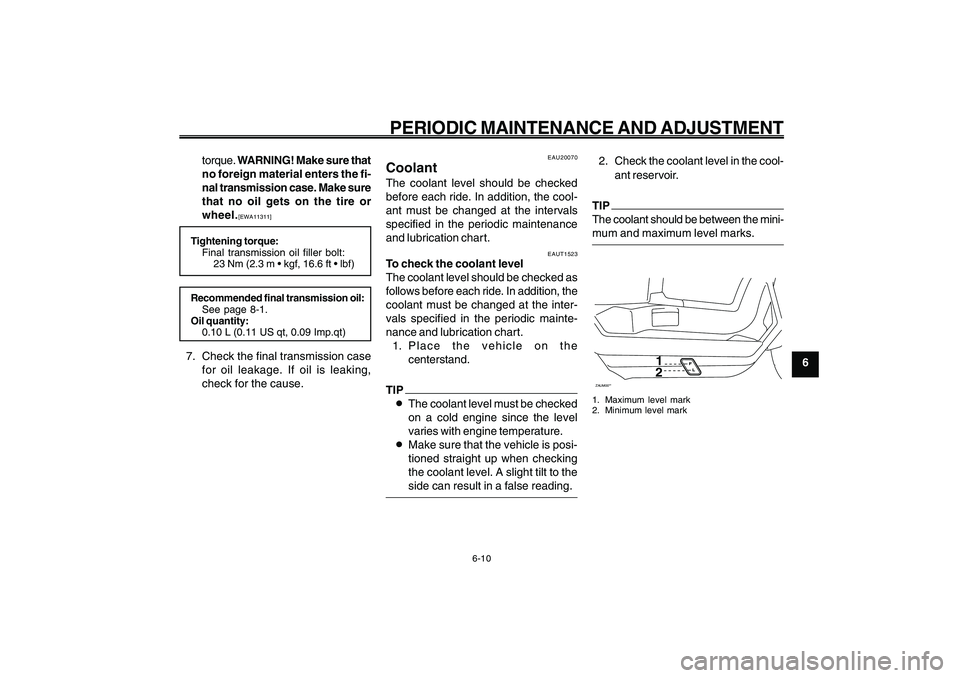
6-45
1
2
3
4
5
6
7
8
9
EAU1722A
PERIODIC MAINTENANCE AND ADJUSTMENT
6-10
torque. WARNING! Make sure that
no foreign material enters the fi-
nal transmission case. Make sure
that no oil gets on the tire or
wheel.
[EWA11311]
Tightening torque:
Final transmission oil filler bolt:
Recommended final transmission oil:
See page 8-1.
Oil quantity:
0.10 L (0.11 US qt, 0.09 Imp.qt)7. Check the final transmission case
for oil leakage. If oil is leaking,
check for the cause.
EAU20070
CoolantThe coolant level should be checked
before each ride. In addition, the cool-
ant must be changed at the intervals
specified in the periodic maintenance
and lubrication chart. Coolant
EAUT1523
To check the coolant level
The coolant level should be checked as
follows before each ride. In addition, the
coolant must be changed at the inter-
vals specified in the periodic mainte-
nance and lubrication chart.
1. Place the vehicle on the
centerstand.TIP
8The coolant level must be checked
on a cold engine since the level
varies with engine temperature.
8Make sure that the vehicle is posi-
tioned straight up when checking
the coolant level. A slight tilt to the
side can result in a false reading.
2. Check the coolant level in the cool-
ant reservoir.TIP
The coolant should be between the mini-
mum and maximum level marks.ZAUM00**
12
1. Maximum level mark
2. Minimum level mark
Page 61 of 74
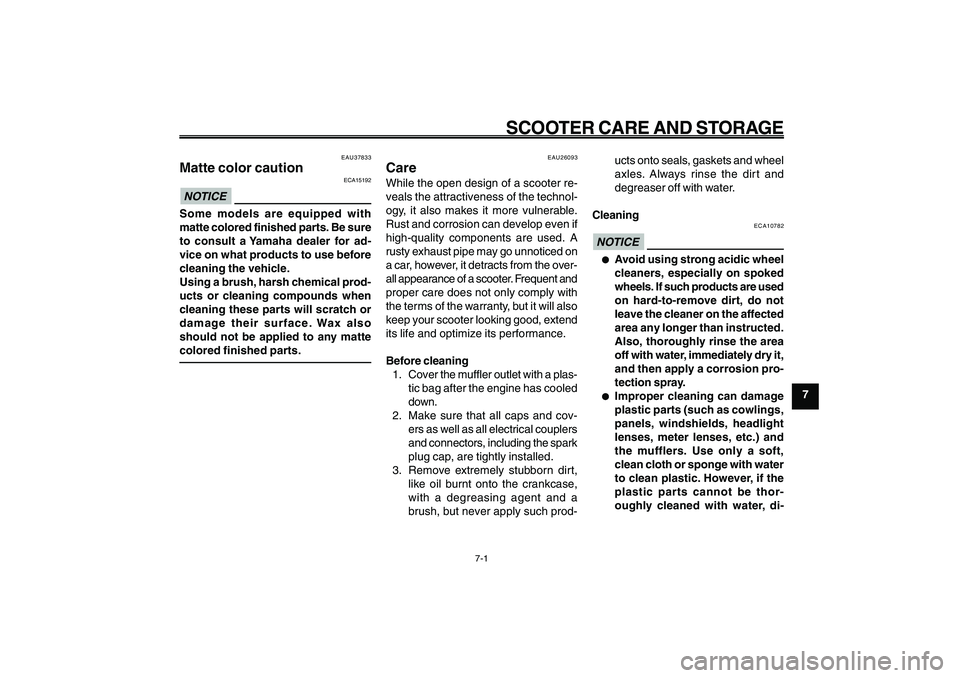
7-61
1
2
3
4
5
6
7
8
9
EAU25991
SCOOTER CARE AND STORAGE
7-1
EAU25991
SCOOTER CARE AND STORAGE
EAU37833
Matte color caution
ECA15192
NOTICESome models are equipped with
matte colored finished parts. Be sure
to consult a Yamaha dealer for ad-
vice on what products to use before
cleaning the vehicle.
Using a brush, harsh chemical prod-
ucts or cleaning compounds when
cleaning these parts will scratch or
damage their surface. Wax also
should not be applied to any matte
colored finished parts.Matte color, caution
Care
EAU26093
CareWhile the open design of a scooter re-
veals the attractiveness of the technol-
ogy, it also makes it more vulnerable.
Rust and corrosion can develop even if
high-quality components are used. A
rusty exhaust pipe may go unnoticed on
a car, however, it detracts from the over-
all appearance of a scooter. Frequent and
proper care does not only comply with
the terms of the warranty, but it will also
keep your scooter looking good, extend
its life and optimize its performance.
Before cleaning
1. Cover the muffler outlet with a plas-
tic bag after the engine has cooled
down.
2. Make sure that all caps and cov-
ers as well as all electrical couplers
and connectors, including the spark
plug cap, are tightly installed.
3. Remove extremely stubborn dirt,
like oil burnt onto the crankcase,
with a degreasing agent and a
brush, but never apply such prod-ucts onto seals, gaskets and wheel
axles. Always rinse the dirt and
degreaser off with water.
Cleaning
ECA10782
NOTICE● ●● ●
●
Avoid using strong acidic wheel
cleaners, especially on spoked
wheels. If such products are used
on hard-to-remove dirt, do not
leave the cleaner on the affected
area any longer than instructed.
Also, thoroughly rinse the area
off with water, immediately dry it,
and then apply a corrosion pro-
tection spray.
● ●● ●
●
Improper cleaning can damage
plastic parts (such as cowlings,
panels, windshields, headlight
lenses, meter lenses, etc.) and
the mufflers. Use only a soft,
clean cloth or sponge with water
to clean plastic. However, if the
plastic parts cannot be thor-
oughly cleaned with water, di-
Page 64 of 74

7-64
1
2
3
4
5
6
7
8
9
EAU25991
SCOOTER CARE AND STORAGE
7-4
stabilizer (if available) to prevent the
fuel tank from rusting and the fuel
from deteriorating.
3. Perform the following steps to pro-
tect the cylinder, piston rings, etc.
from corrosion.
a. Remove the spark plug cap and
spark plug.
b. Pour a teaspoonful of engine oil
into the spark plug bore.
c. Install the spark plug cap onto
the spark plug, and then place
the spark plug on the cylinder
head so that the electrodes are
grounded. (This will limit spark-
ing during the next step.)
d. Turn the engine over several
times with the starter. (This will
coat the cylinder wall with oil.)
e. Remove the spark plug cap from
the spark plug, and then install
the spark plug and the spark plug
cap. WARNING! To prevent dam-
age or injury from sparking,
make sure to ground the sparkplug electrodes while turning
the engine over.
[EWA10951]
4. Lubricate all control cables and the
pivoting points of all levers and
pedals as well as of the sidestand/
centerstand.
5. Check and, if necessary, correct
the tire air pressure, and then lift
the scooter so that both of its
wheels are off the ground. Alterna-
tively, turn the wheels a little every
month in order to prevent the tires
from becoming degraded in one
spot.
6. Cover the muffler outlet with a plas-
tic bag to prevent moisture from en-
tering it.
7. Remove the battery and fully charge
it. Store it in a cool, dry place and
charge it once a month. Do not store
the battery in an excessively cold
or warm place [less than 0 °C (30
°F) or more than 30 °C (90 °F)]. For
more information on storing the
battery, see page 6-19. Storage
EAU36561
StorageShort-term
Always store your scooter in a cool, dry
place and, if necessary, protect it against
dust with a porous cover.
ECA10820
NOTICE● ●● ●
●
Storing the scooter in a poorly
ventilated room or covering it
with a tarp, while it is still wet,
will allow water and humidity to
seep in and cause rust.
● ●● ●
●
To prevent corrosion, avoid
damp cellars, stables (because of
the presence of ammonia) and
areas where strong chemicals are
stored.
Long-term
Before storing your scooter for several
months:
1. Follow all the instructions in the
“Care” section of this chapter.
2. Fill up the fuel tank and add fuel